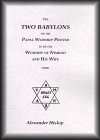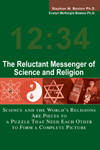
Introduction
Preface Second Ed.
Preface Third Ed.
Note by the Editor
The Two Systems
Trinity in Unity
Mother and Child
The Child in Assyria
The Child in Egypt
The Child in Greece
Death of the Child
Deification of the Child
Mother of the Child
Christmas
Easter
Nativity of John
Feast of thr Assumption
Baptismal Regeneration
Justification by Works
Sacrifice of the Mass
Extreme Unction
Purgatory and Prayers for the Dead.
Idol Processions
Relic Worship.
Clothing and Crowning of Images.
The Rosary
Lamps & Wax-candles
Sign of the Cross
Sovereign Pontiff
Priests, Monks, and Nuns.
Great Red Dragon
Beast From the Sea
Beast from the Earth
Image of the Beast
Number of the Beast
Invisible Head of the Papacy
Woman with Golden Cup
Hebrew Chronology
Shing Moo and Ma Tsoopo of China.
Ala-Mahozim
Meaning of the name Centaurus
Olenos, the Sin-Bearer
Identification of Rhea or Cybele and Venus
Virgin Mother of Paganism
Goddess Mother as a Habitation.
Meaning of the name Astarte.
Oannes and Souro
The Identity of the Scandinavian Odin and Adon of Babylon
Stripping of the Clothes of the Initiated in the Mysteries
Zoroaster, the Head of the Fire-Worshippers
Story of Phaethon
Roman Imperial Standard of the Dragon of Symbol of Fire-worship
The Slaying of the Witness
Attes, the Sinner
Click here for The Reluctant Messenger (Host Site)
APPENDIX - The Meaning of the name Astarte.
NOTE J, p. 110. The Meaning of the name Astarte.
That Semiramis, under the name of Astarte, was worshipped not only as an incarnation of the Spirit of God, but as the mother of mankind, we have very clear and satisfactory evidence. There is no doubt that "the Syrian goddess" was Astarte (LAYARD'S Nineveh and its Remains, vol. ii. p. 456). Now, the Assyrian goddess, or Astarte, is identified with Semiramis by Athenagoras (Legatio, vol. ii. p. 179), and by Lucian (De Dea Syria, vol iii. p. 382). These testimonies in regard to Astarte, or the Syrian goddess, being, in one aspect, Semiramis, are quite decisive. 1. The name Astarte, as applied to her, has reference to her as being Rhea or Cybele, the tower-bearing goddess, the first, as Ovid says (Opera, vol. iii., Fasti, lib. iv. ll. 219, 220), that "made (towers) in cities;" for we find from Layard, at the page above referred to, that in the Syrian temple of Hierapolis, "she [Dea Syria or Astarte] was represented standing on a lion crowned with towers." Now, no name could more exactly picture forth the character of Semiramis, as queen of Babylon, than the name of "Asht-tart," for that just means "The woman that made towers." It is admitted on all hands that the last syllable "tart" comes from the Hebrew verb "Tr." It has been always taken for granted, however, that "Tr" signifies only "to go round." But we have evidence that, in nouns derived from it, it also signifies "to be round," "to surround," or "encompass." In the masculine, we find "Tor" used for "a border or row of jewels round the head" (see PARKHURST, sub voce No. ii., and also GESENIUS). And in the feminine, as given in Hesychius (Lexicon, p. 925), we find the meaning much more decisively brought out: Turis ho peribolos tou teichous. Turis is just the Greek form of Turit, the final t, according to the genius of the Greek language, being converted into s. Ash-turit, then, which is obviously the same as the Hebrew "Ashtoreth," is just "The woman that made the encompassing wall." Considering how commonly the glory of that achievement, as regards Babylon, was given to Semiramis, not only by Ovid (Opera Metam., lib. iv. fab. 4. 1. 58, vol. ii. p. 177), but by Justin, Dionysius, Afer, and others, both the name and mural crown on the head of that goddess were surely very appropriate. In confirmation of this interpretation of the meaning of the name Astarte, I may adduce an epithet applied to the Greek Diana, who at Ephesus bore a turreted crown on her head, and was identified with Semiramis, which is not a little striking. It is contained in the following extract from Livy (lib. xliv. cap. 44, vol. vi. pp. 57, 58): "When the news of the battle [near Pydna] reached Amphipolis, the matrons ran together to the temple of Diana, whom they style Tauropolos, to implore her aid." Tauropolos, from Tor, "a tower," or "surrounding fortification," and Pol, "to made," plainly means the "tower-maker," or "maker of surrounding fortifications;" and to her as the goddess of fortifications, they would naturally apply when they dreaded an attack upon their city.
Semiramis, being deified as Astarte, came to be raised to the highest honours; and her change into a dove, as has been already shown (p. 79, ante), was evidently intended, when the distinction of sex had been blasphemously attributed to the Godhead, to identify her, under the name of the Mother of the gods, with that Divine Spirit, without whose agency no one can be born a child of God, and whose emblem, in the symbolical language of Scripture, was the Dove, as that of the Messiah was the Lamb. Since the Spirit of God is the source of all wisdom, natural as well as spiritual, arts and inventions and skill of every kind being attributed to Him (Exod. xxxi. 3, and xxxv. 31), so the Mother of the gods, in whom that Spirit was feigned to be incarnate, was celebrated as the originator of some of the useful arts and sciences (DIODORUS SICULUS, lib. iii. p. 134). Hence, also, the character attributed to the Grecian Minerva, whose name Athena, as we have seen reason to conclude, is only a synonym for Beltis, the well-known as the "goddess of wisdom," the inventress of arts and sciences. 2. The name Astarte signifies also the "Maker of investigations;" and in this respect was applicable to Cybele or Semiramis, as symbolised by the Dove. That this is one of the meanings of the name Astarte may be seen from comparing it with the cognate names Asterie and Astraea (in Greek Astraia), which are formed by taking the last member of the compound word in the masculine, instead of the feminine, Teri, or Tri (the latter being pronounced Trai or Trae), being the same in senses as Tart. Now, Asterie was the wife of Perseus, the Assyrian (HERODOTUS, lib. vi. p. 400), and who was the founder of Mysteries (BRYANT, vol. iii. pp. 267, 268). As Asterie was further represented as the daughter of Bel, this implies a position similar to that of Semiramis. Astraea, again, was the goddess of justice, who is identified with the heavenly virgin Themis, the name Themis signifying "the perfect one," who gave oracles (OVID, Metam, lib. i. fab. 7, vol. ii. p. 30), and who, having lived on earth before the Flood, forsook it just before that catastrophe came on (Ibid. Note). Themis and Astraea are sometimes distinguished and sometimes identified; but both have the same character as goddess of justice (see Gradus ad Parnassum, sub voce "Justitia"). The explanation of the discrepancy obviously is, that the Spirit has sometimes been viewed as incarnate and sometimes not. When incarnate, Astraea is daughter of Themis. What name could more exactly agree with the character of a goddess of justice, than Ash-trai-a, "The maker of investigations," and what name could more appropriately shadow forth one of the characters of that Divine Spirit, who "searcheth all things, yea, the deep things of God"? As Astraea, or Themis, was "Fatidica Themis," "Themis the prophetic," this also was another characteristic of the Spirit; for whence can any true oracle, or prophetic inspiration, come, but from the inspiring Spirit of God? Then, lastly, what can more exactly agree with the Divine statement in Genesis in regard to the Spirit of God, than the statement of Ovid, that Astraea was the last of the celestials who remained on earth, and that her forsaking it was the signal for the downpouring of the destroying deluge? The announcement of the coming Flood is in Scripture ushered in with these words: (Gen. vi. 3), "And the Lord said, My Spirit shall not always strive with man, for that he also is flesh: yet his days shall be an hundred and twenty years." All these 120 years, the Spirit was striving; when they came to an end, the Spirit strove no longer, forsook the earth, and left the world to its fate. But though the Spirit of God forsook the earth, it did not forsake the family of righteous Noah. It entered with the patriarch into the ark; and when that patriarch came forth from his long imprisonment, it came forth along with him. Thus the Pagans had an historical foundation for their myth of the dove resting on the symbol of the ark in the Babylonian waters, and the Syrian goddess, or Astarte--the same as Astraea--coming forth from it. Semiramis, then, as Astarte, worshipped as the dove, was regarded as the incarnation of the Spirit of God. 3. As Baal, Lord of Heaven, had his visible emblem, the sun, so she, as Beltis, Queen of Heaven, must have hers also--the moon, which in another sense was Asht-tart-e, "The maker of revolutions;" for there is no doubt that Tart very commonly signifies "going round." But, 4th, the whole system must be dovetailed together. As the mother of the gods was equally the mother of mankind, Semiramis, or Astarte, must also be identified with Eve; and the name Rhea, which, according to the Paschal Chronicle, vol. i. p. 65, was given to her, sufficiently proves her identification with Eve. As applied to the common mother of the human race, the name Astarte is singularly appropriate; for, as she was Idaia mater, "The mother of knowledge," the question is, "How did she come by that knowledge?" To this answer can only be: "By the fatal investigations she made." It was a tremendous experiment she made, when, in opposition to the Divine command, and in spite of the threatened penalty, she ventured to "search" into that forbidden knowledge which her Maker in his goodness had kept from her. Thus she took the lead in that unhappy course of which the Scripture speaks--"God made man upright, but they have SOUGHT out many inventions" (Eccles. vii. 29). Now Semiramis, deified as the Dove, was Astarte in the most gracious and benignant form. Lucius Ampelius (in Libro ad Macrinum apud BRYANT, vol. iii. p. 161) calls her "Deam benignam et misericordem hominibus ad vitam bonam," "The goddess benignant and merciful to men" (bringing them) "to a good and happy life." In reference to this benignity of her character, both the titles, Aphrodite and Mylitta, are evidently attributed to her. The first I have elsewhere explained as "The wrath-subduer' (ante, p. 158), and the second is in exact accordance with it. Mylitta, or, as it is in Greek, Mylitta, signifies "The Mediatrix." The Hebrew Melitz, which in Chaldee becomes Melitt, is evidently used in Job xxxiii. 23, in the sense of a Mediator; "the messenger, the interpreter" (Melitz), who is "gracious" to a man, and saith, "Deliver from going down to the pit: I have found a ransom," being really "The Messenger, the MEDIATOR." Parkhurst takes the word in this sense, and derives it from "Mltz," "to be sweet," Now, the feminine of Melitz is Melitza, from which comes Melissa, a "bee" (the sweetener, or producer of sweetness), and Melissa, a common name of the priestesses of Cybele, and as we may infer of Cybele, as Astarte, or Queen of Heaven, herself; for, after Porphyry, has stated that "the ancients called the priestesses of Demeter, Melissae," he adds, that they also "called the Moon Melissa" (Deantro Nympharum, p. 18). We have evidence, further, that goes far to identify this title as a title of Semiramis. Melissa or Melitta (APOLLODORUS, vol. i. lib. ii. p. 110)--for the name is given in both ways--is said to have been the mother of Phoroneus, the first that reigned, in whose days the dispersion of mankind occurred, divisions having come in among them, whereas before, all had been in harmony and spoke one language (Hyginus, fab. 143, p. 114). There is no other to whom this can be applied but Nimrod; and as Nimrod came to be worshipped as Nin, the son of his own wife, the identification is exact. Melitta, then, the mother of Phoroneus, is the same as Mylitta, the well-known name of the Babylonian Venus; and the name, as being the feminine of Melitz, the Mediator, consequently signifies the Mediatrix. Another name also given to the mother of Phoroneus, "the first that reigned," is Archia (LEMPRIERE; see also SMITH, p. 572). Now Archia signifies "Spiritual" (from "Rkh," Heb. "Spirit," which in Egyptian also is "Rkh" (BUNSEN, vol. i. p. 516, No. 292); and in Chaldee, with the prosthetic a prefixed becomes Arkh). * From the same root also evidently comes the epithet Architis, as applied to the Venus that wept for Adonis. * Venus Architis is the spiritual Venus. * Thus, then, the mother-wife of the first king that reigned was known as Archia and Melitta, in other words, as the woman in whom the "Spirit of God" was incarnate; and thus appeared as the "Dea Benigna," "The Mediatrix" for sinful mortals. The first form of Astarte, as Eve, brought sin into the world; the second form before the Flood, was avenging as the goddess of justice. This form was "Benignant and Merciful." Thus, also Semiramis, or Astarte, as Venus the goddess of love and beauty, became "The HOPE of the whole world," and men gladly had recourse to the "mediation" of one so tolerant of son.
Previous | Next

or The Papal Worship Proved to be the Worship of Nimrod and His Wife
$3.99 Kindle eBook
Buy from Amazon.com
The Essential Teachings of Herbert W. Armstrong
His Teachings Focused on The Incredible Human Potential. Did He Solve the Mystery of the Ages?
New Book about HWA's Teachings. Recommended!

